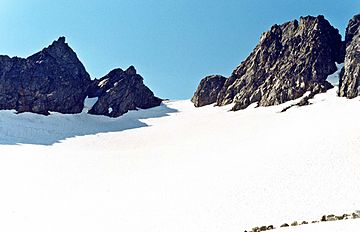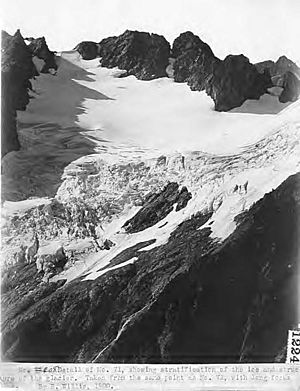Cache Col facts for kids
Quick facts for kids Cache Col |
|
|---|---|
 |
|
| Highest point | |
| Elevation | 6,903 ft (2,104 m) |
| Geography | |
| Parent range | North Cascades |
| Topo map | USGS Cascade Pass |
Cache Col is a high mountain pass, or a "gap," located in the North Cascades mountains. It sits on a ridge between two peaks called Magic Mountain and Mix-up Peak. This special spot is found at the very top of the Cache Glacier.
Cache Col is right on the border between Skagit County and Chelan County in Washington state. It's south of Cascade Pass, where North Cascades National Park meets the Glacier Peak Wilderness. Cache Col and the Cache Glacier are also the start of a famous climbing path called the Ptarmigan Traverse. This route helps climbers reach faraway peaks like Mount Formidable and Dome Peak. Water from the north side of Cache Col flows into the Stehekin River. Water from the south side flows into the Cascade River.
Understanding the Climate at Cache Col
Cache Col is in a "marine west coast" climate zone. This means it gets a lot of weather from the Pacific Ocean. Most weather systems travel northeast towards the Cascade Range. As these systems hit the tall Cascade Mountains, they are forced to rise.
When the air rises, it cools down and drops its moisture. This causes a lot of rain or snowfall on the western side of the North Cascades. This process is called "orographic lift." Because of this, winters here have heavy snowfall. Summers often have clear skies due to high pressure systems over the Pacific Ocean. The snow tends to be wet and heavy, which can lead to a high risk of avalanches.
How the Geology of the North Cascades Formed
The North Cascades mountains have very rugged land. You can see jagged peaks, sharp ridges, and deep valleys carved by glaciers. There are also tall spires made of granite. Long ago, huge geological events created this amazing landscape. These events caused big changes in elevation, which led to different climates. These climate differences then created various plant zones, or "ecoregions," in the area.
The Cascade Mountains started forming millions of years ago, during the late Eocene Epoch. This happened because the North American Plate was slowly moving over the Pacific Plate. This movement caused many volcanic eruptions. Also, small pieces of the Earth's crust, called terranes, came together to form the North Cascades about 50 million years ago.
Over two million years ago, during the Pleistocene period, glaciers repeatedly moved across the land. As they moved, they scraped away rock and left behind debris. The "U"-shaped valleys you see today were carved by these glaciers. The combination of land uplift (when land pushes up) and faulting (when cracks form in the Earth's crust) along with glaciation created the tall peaks and deep valleys of the North Cascades.





